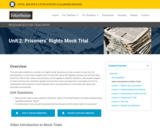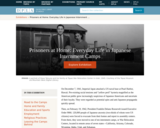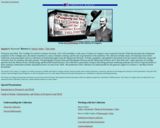
This is a full lesson, activity, and PowerPoint about President Andrew Johnson's impeachment.
- Subject:
- U.S. History
- Material Type:
- Lesson Plan
- Date Added:
- 05/21/2024

This is a full lesson, activity, and PowerPoint about President Andrew Johnson's impeachment.

On Tuesday, January 20, 2009, the presidential oath of office was administered for the seventieth time, the fifty-eighth such ceremony in a location in Washington, D.C, the fifty-second at the United States Capitol, and the seventh on the west front of the Capitol; but even more historically, for the first time in American history it was taken by an African American.

This manual provides you with a variety of creative and engaging strategies to help students think about how wars have been defining moments in both the history of the nation and the lives of individual Americans.

This manual provides you with a variety of creative and engaging strategies to help students think about how wars have been defining moments in both the history of the nation and the lives of individual Americans.

Examine a collection of primary source documents about automobiles in American history.

Examine a collection of primary source documents about highways in the United States.

Examine a collection of primary source documents of drawings created for patents.

Examine a collection of primary source documents about railroads in the United States.

Examine a collection of primary source documents about the Wright Brothers.

This unit asks students to consider civil rights inside the prison as they conduct a mock trial. By participating in a mock trial, students will not only learn about the litigation process, but will also learn about how democratic values and principles can be applied to specific situations, why people disagree on when and how they should be applied, and how the courts are important in providing a forum for contestation and resolution of such disputes and in ensuring that our commonly held values and principles are protected.
This Unit contains 6 lessons:
Lesson 1: What is this case about?
Lesson 2: Understanding the Evidence
Lesson 3: Developing an Outline for the Case
Lesson 4: Preparing for Trial
Lesson 5: The Trial
Lesson 6: Debrief and Reflection

On December 7, 1941, Imperial Japan attacked a US naval base at Pearl Harbor, Hawaii. Pre-existing racial tensions and yellow peril hysteria magnified as the American public grew increasingly suspicious of Japanese Americans and uncertain of their loyalty. They were regarded as potential spies and anti-Japanese propaganda quickly spread. Then, on February 19, 1942, President Franklin Delano Roosevelt issued Executive Order 9066. 120,000 people of Japanese ancestry (two-thirds of whom were US citizens) were forced to evacuate from their homes and report to assembly centers. From there, they were moved to one of ten internment camps, or War Relocation Centers, located in remote areas of seven statesCalifornia, Arizona, Colorado, Wyoming, Idaho, Utah, and Arkansas.For the next three years, Japanese Americans acclimated to life behind barbed wire and under armed guard. Uprooted from their lives, they found themselves in strange and uncomfortable environments. They had to adapt to their new situation by adjusting to new living conditions, attending new schools, and finding inventive ways to pass the time. They attempted to maintain a sense of normalcy by attending religious meetings and by finding employment.This exhibition tells stories of everyday lives in Japanese Internment camps during World War II. It was created as part of the DPLAs Digital Curation Program by the following students as part of Dr. Joan E. Beaudoin's course "Metadata in Theory and Practice" in the School of Library and Information Science at Wayne State University: Stephanie Chapman, Jessica Keener, Nicole Sobota, and Courtney Whitmore.

The early twentieth century saw a huge number of Progressive reform movements, which aimed to improve labor, sanitation, conservation, voting rights, and morality. With so many different avenues of reform, how can we define who the Progressives really were? In this video, Kim compares the goals and effects of the Progressive reform movement.

This collection assembles a wide array of Library of Congress source materials from the 1920s that document the widespread prosperity of the Coolidge years, the nation's transition to a mass consumer economy, and the role of government in this transition. It includes nearly 200 selections from twelve collections of personal papers and two collections of institutional papers from the Manuscript Division; 74 books, pamphlets, and legislative documents from the General Collections, along with selections from 34 consumer and trade journals; 181 photographs from the pictorial materials of the National Photo Company Collection held by the Prints and Photographs Division; and 5 short films and 7 audio selections of Coolidge speeches from the Motion Picture, Broadcasting, and Recorded Sound Division. The collection is particularly strong in advertising and mass-marketing materials and will be of special interest to those seeking to understand economic and political forces at work in the 1920s.

How did the development of water transportation routes affect commerce and immigration in the United States? This portion of the Public Sculpture module identifies symbols of river and canal communities and describes Cincinnati history as it relates to the Ohio River.

How did the civil rights movement gain momentum in the United States during the 1950s and 1960s? This portion of the Public Sculpture module explains the fundamental democratic principles behind the civil rights movement.

How do memorials convey American attitudes toward wars? This portion of the Public Sculpture module describes the assault on Iwo Jima, the flag raising on Mount Suribachi, and the resulting photographs and memorial.

How can a memorial convey the ideals of the memorialized? This portion of the Public Sculpture module explains how symbols create political identity.

What contribution did pioneer women make to life in the West? This portion of the Public Sculpture module explains the Madonna of the Trail project.

What contributions were made by African-American troops participating in the Civil War? This portion of the Public Sculpture module explains how art expresses heroic ideals.

What was the Mexican contribution to the cowboy heritage? This portion of the Public Sculpture module explains stereotypes and the difference between real and mythical cowboys.